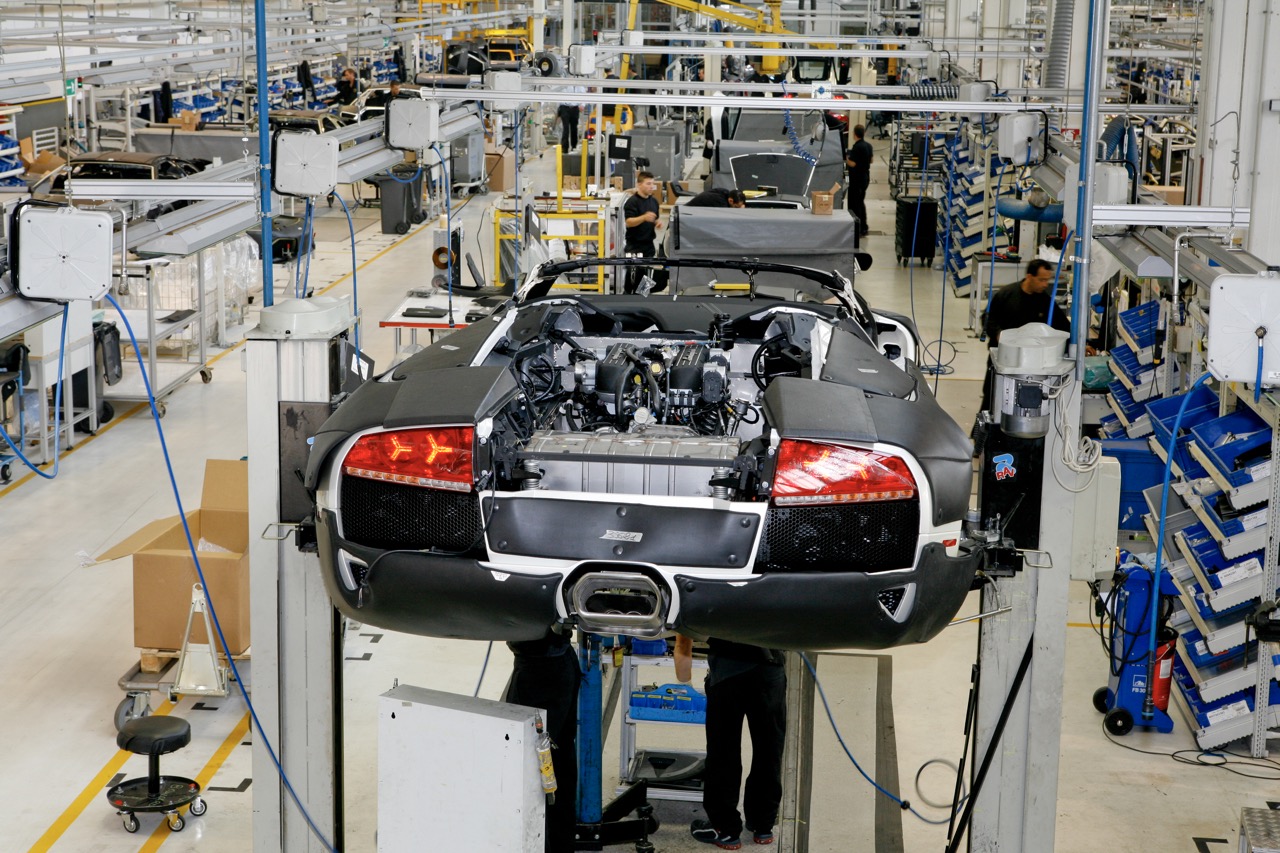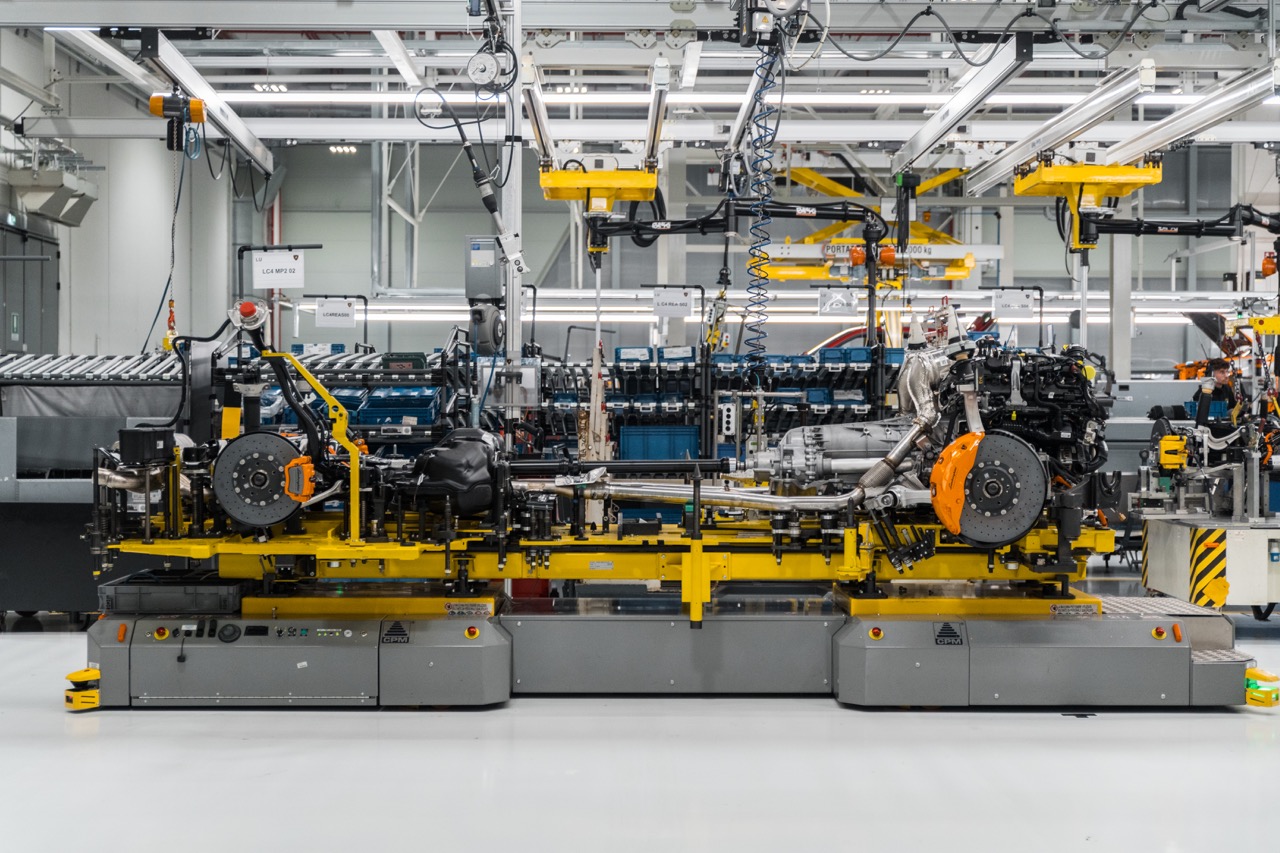Lamborghini turned 60 this year, and while its latest is a 1,001-horsepower hybrid V12 hybrid supercar, perhaps even more exciting are these incredible photos that Lamborghini recently released showing the factory throughout the years. Let’s take a close look at a team in Sant’Agata Bolognese that was so technologically forward-thinking that first Chrysler, and then Audi, had to get in on the action.
Have you seen Bobby Moresco’s Ferruccio Lamborghini biopic last year? If not, please do yourself a favor and keep it that way. Motion picture or not, most stories focus on his beef with Enzo Ferrari anyway, as though that’s what made Lamborghini what it is. What’s more important is that the carmaker recently released a heap of archive images to celebrate the factory’s 60th, so let’s dig in to those.
The Fascinating History Of Lamborghini
Post-war Italy had plenty of military surplus left behind by the Allies, which is why the new government set up a system to sell off all those truck engines, chassis and differentials. Ferruccio Lamborghini’s first big breakthrough was a patented atomizer that could start a Morris six-cylinder engine on gasoline before switching it to the cheaper diesel fuel. Starting in 1948, this technology was used to power compact tractors, and agricultural machinery company Lamborghini Trattori was set to make the most of the country’s economic boom.



Once war stocks were running low, Ferruccio Lamborghini imported Mercedes diesels to continue production, only to build his own engine and gearbox factory by 1955. Debuting three years later, the Lamborghinetta tractor used the new in house powertrain to beat Fiat, Landini, Valpadana and more in the business.
By the sixties, Lamborghini was an established industrialist and significant employer in Emilia-Romagna, producing oil heaters and air-conditioning units alongside his tractors. However, no money could change the fact that all of his Ferraris had garbage interiors and even worse clutches, which is why he ended up being so frustrated with Enzo that he built his own car factory. A then very modern concrete structure that’s still the home of Lamborghini today.




Ferruccio Lamborghini understood that all the know-how was within his reach. The best engineers, designers and machinists in the region, ready to spend his fortunes on producing luxury cars. The first Lamborghini, the 350 GT developed from Scaglione’s striking GTV prototype, wasn’t supposed to work with its fresh V12. The transverse mid-engine Miura penned by young Marcello Gandini wasn’t supposed to make it as the world’s first proper supercar. The succeeding Countach wasn’t supposed to be built like a freaking Le Mans prototype, since Ferruccio was all about the luscious GT experience, right?






To be fair to Ferruccio, he cut his losses and sold the struggling car business to Swiss entrepreneurs long before the Countach could hit the market, only to focus on the marine engines, air-conditioners and hydraulic valves also bearing his name. Prior to that, Automobili Lamborghini opened its own engine and gearbox production line in 1968, only so that a decade later, 1979’s output could drop to 55 units. Unsustainable.



Due to several such low points and the general lack of investment, the Countach remained in production from 1974 until 1990. A whopping 26 years even if you don’t mind that the prototype LP500 debuted at the 1971 Geneva Motor Show.
Still, in 1983, Lamborghini managed to start something major in Sant’Agata: its experiments with carbon fiber. The new ‘Esperienza Materiali Compositi’ Department (E.Co) sourced technology from Seattle, where Boeing was already busy using both carbon and Kevlar in the 767 program.


People like Horacio Pagani and Giancarlo Barbieri were part of the R&D department team, and by 1987, the Countach Evoluzione was ready to be crash tested in the name of science. Lamborghini sold 470 cars and 300 marine V12s that year, yet the idea of a carbon fiber road car remained out of the question.
The Diablo’s development seemingly took forever. By the time Chrysler saved the company and scrapped Gandini’s original P132 design to let Tom Gale bring the new suppercar into the nineties, Lamborghini’s real power was in engine development, metallurgy and composites. Thanks to this new synergy, the Dodge Viper could end up with a cast aluminum V10 instead of a cast iron one. Lamborghini’s huge autoclave also led to several series production carbon fiber parts on later Diablos, including unpainted wings and trim pieces.





Unlike the complex tubular frame of the Countach, the Diablo was built over a more conventional steel box frame you can even see on the screen in the picture above. It’s important to note that while the now 5.7-liter Lamborghini V12 got Bosch multi-port fuel injection instead of the former Weber carburettors, the Diablo soon offered power steering and the LM002’s modified all-wheel drive system as well. This was five years before Audi.




Evolving Diablo or not, Lamborghini desperately needed a second model with a smaller engine to boost volume. To get there, the company wanted to source the reliable and tunable 4.2-liter V8 from the Audi A8, along with its advanced mechanical all-wheel drive system. However, Ferdinand Piëch saw an opportunity in Lamborghini, and bought the entire company through Audi. After 1998, the Italians could continue their previously shelved V10 development.
Following his successful stint with the Bugatti EB110’s 3.5-liter quad-turbo V12, the V10 became then newcomer Maurizio Reggiani’s project. Lamborghini was still selling in the hundreds at this time, and not many supercar companies had the capability to design a new engine in house anyway.


Lamborghini could, and while the 5.0 V10 was later turned into the 5.2 Audi V10 in order for it to have the same bore spacing as the Audi 4.2 V8 with the addition of the ‘Fuel Stratified Injection’ (FSI) system, the Lamborghini factory certainly did not become an empty subsidiary.
Forged carbon is just one of Lamborghini’s more recent patented technologies, and while production outputs are now sky-high compared to the past, the new hybrid supercar, the V12 Revuelto is sold out for two years since day one. The Urus SUV may seem like an Audi SQ7 in beef with the Porsche Cayenne Turbo GT, yet the factory where it’s produced remains in the middle of nowhere, between the fields where a man who liked tractors put it back in 1963.

If some internet warrior tells you all 2884 Lamborghini Diablos were built like crap, just do a slideshow of these archive images and point out to them the protective film on the red one, the dude wearing the lab coat next to all that highly advanced testing equipment, the carefully planned wiring diagram displayed on the board, the precision welding by that unnamed Italian artisan, or perhaps that neat Coke machine that was already operational during the Countach-era. As for that white Diablo with red interior, my lord! I guess that’s how I’ll need to order my 2027 Revuelto.
All Images: Lamborghini








Nice to see your work here Mr Petrány. The Italian sense of style is a wonder. However, I saw a(an?) Urus today. Ack!
Thanks! I’m always on the fence with the Urus. On one hand, no. Just no, so ack is correct. On the other, drive one, and it’s proper ridiculious. Plus, unlike an LM002, it’s not bad.
The picture they don’t show, the forever-shame of the British people: crash testing the original LP500 prototype at MIRA, after adding air scoops and NACA ducts and before sending it off to be crushed:
http://www.countach.ch/History/LP500/lp500_5.jpeg
The whole piece is well worth a read and some amazing photos:
http://www.countach.ch/History/LP500/index.html
What’s amazing is that they had to go to MIRA to do all these tests.
They probably had trouble in Italy finding the sort of Philistine capable of hacking up a work of industrial art, then smashing it into a concrete barrier and selling it for scrap. The horrible paradox being that the LP500 was a monocoque whose crash structure bore no relation to that of the production car.
Very cool. How do you guys keep all this awesome content coming every day?
That picture with the Miuras on the line gives me all the feels.
After all these years, I’m still trying to get over my first in-person sighting of a 400 GT. Sensational car.
Some time later, I drove a Miura. Despite later experiences with a Countach and having looked at several Gallardii and Diablii, Lamborghini peaked for me early on. Won’t ever be able to afford one, but I can dream….
For some reason, I really want to try an Islero. An Islero S.
The Lamborghini factory being in a seemingly random small rural town is hard to comprehend until you’ve been there. It’s a great trip though.
It is absolutely worth the visit. A great museum, plus good food all around, surrounded by stunning vineyards. Just a win.